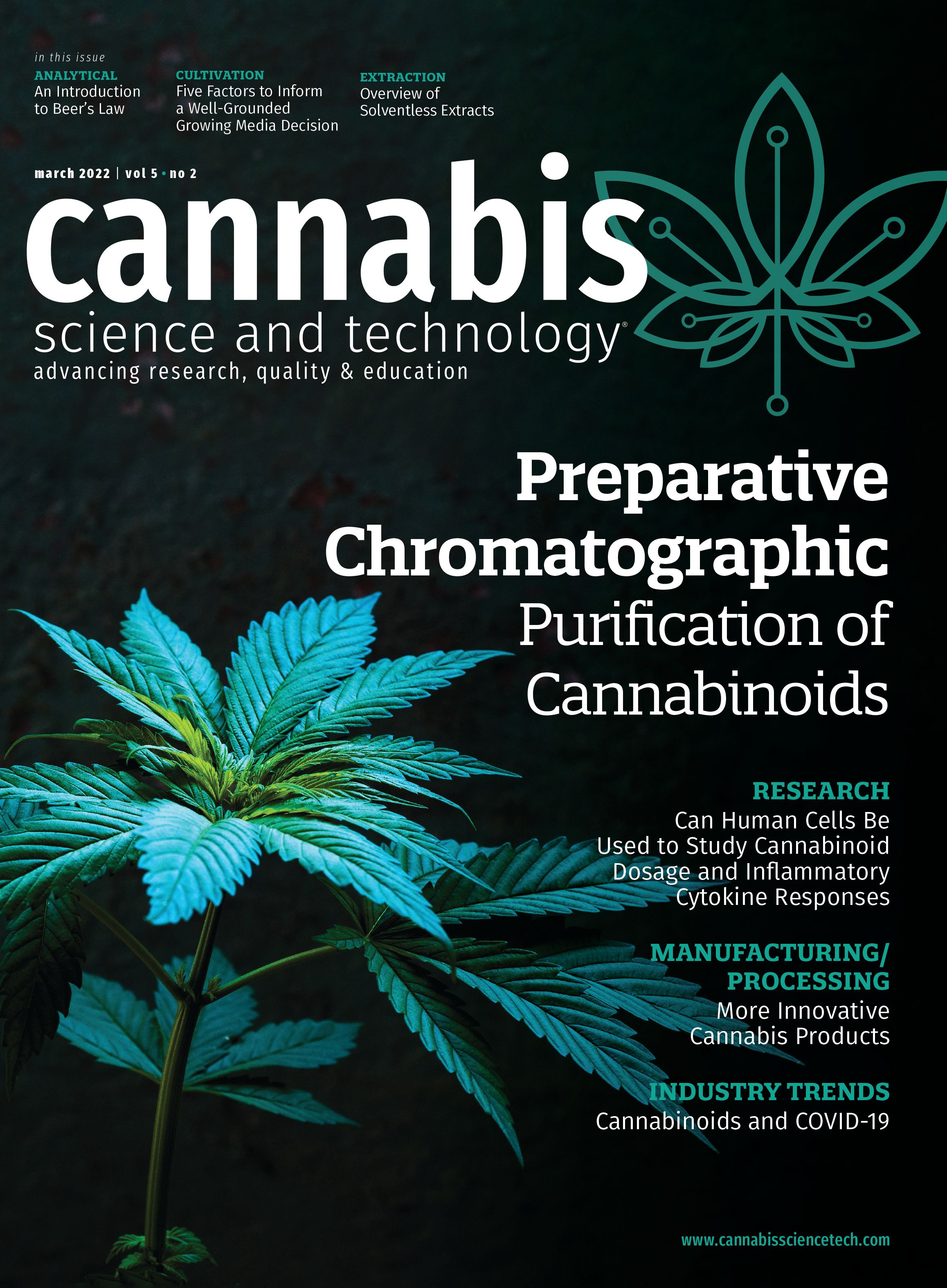Human Cells Can Be Used to Study Cannabinoid Dosage and Inflammatory Cytokine Responses
It is demonstrated in this paper that cell viability can be used to determine dose and response effects that are important in understanding toxicities and to detect differences in similar hemp products.
Gas and liquid chromatography coupled to mass spectrometry allow the precise fingerprinting of cannabinoids, terpenes, and flavonoids in different hemp cultivars. However, little is known about how these cultivars or cannabidiol (CBD) products, in general, affect human cells. Techniques in modern cell biology allow for cannabis dosage and toxicity determinations, the study of genetic and protein pathways, apoptosis pathways, and chemical screening in a variety of well-characterized cells. There can be significant utility in using living cell culture systems in the evaluation of hemp products. For example, it is demonstrated in this paper that cell viability can be used to determine dose and response effects that are important in understanding toxicities and to detect differences in similar hemp products. It is also shown that inflamed peripheral blood mononuclear cells (PBMC) produce large amounts of inflammatory cytokines and that the addition of CBD inhibits this cytokine production. It is clear that cell culture experiments can contribute to understanding the effects of hemp oils in humans.
Testing for the efficacy of cannabinoid chemicals has not kept pace with the rapid advances in chemical detection. There are countless cannabidiol (CBD) products on the market, both in the US and internationally, with various wellness claims. However, basic research data on how these products interact in the human body is lacking. Cannabis plants produce a unique and diverse assortment of several hundred chemicals that include cannabinoids, terpenes, flavonoids, phenols, ketones, aldehydes, and fatty acids. Cannabis plants have complex genetics and there are thousands of genetic combinations that are able to produce individual and specific profiles for each cultivar. Modern gas chromatography (GC) and liquid chromatography (LC) systems coupled with mass spectrometers (MS) can fingerprint the full spectrum of oils present in each cultivar (1). For reasons not yet fully understood, various cultivars have different effect profiles.
Effect profiles is a field of research not sufficiently explored. Until quite recently, there has been minimal research undertaken in an attempt to understand and explain what has been described as the “entourage effect” (2,3).
This is important research to pursue as the synergy between terpenes and cannabinoids are thought to enhance the therapeutic benefits of the plant’s individual components in the treatment of pain, inflammation, depression, cancer, and other disorders (4).
It is common in the cosmetic (5,6), pharmaceutical, and medical fields (7,8) to examine the effects of drugs or chemicals on living human cells. A significant benefit of cell culture assays is the avoidance of most human and animal testing while providing rapid and valuable information about cellular viability, repair, potencies, toxicities, and inflammatory responses under controlled conditions (9).
A research group in Israel, using four different neuroblastoma cell lines, measured cell viability as a function of CBD dosage (10). Their research demonstrated that higher CBD doses, up to 50 µg/mL depending on the neuroblastoma cell line, suppressed cell viability to around 50%. The words of Paracelsus—a Swiss-German Scientist—written more than 500 years ago have proven to be true for cannabidiol: “Poison is in everything, and no thing is without poison. The dosage makes it either a poison or a remedy.”
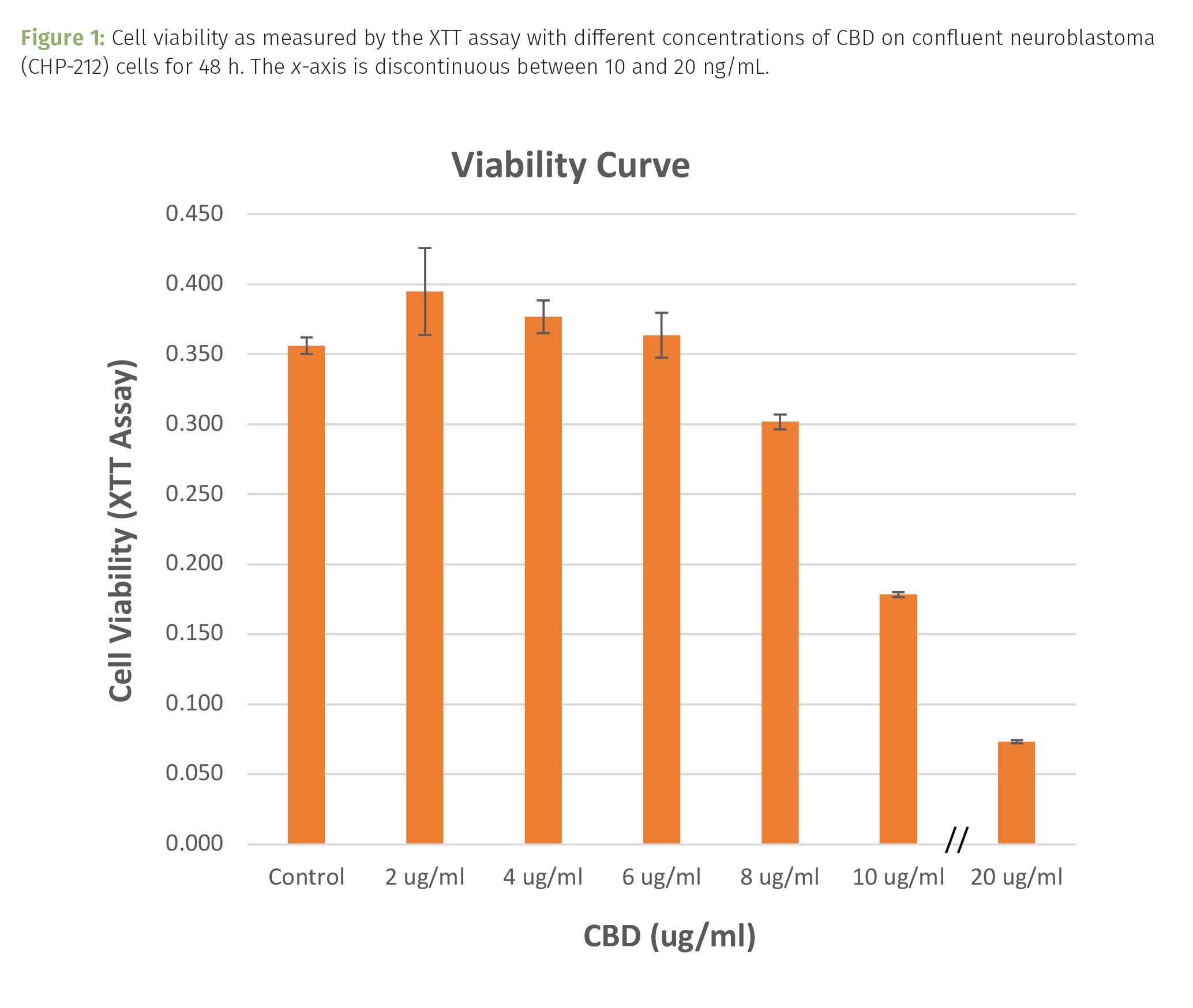
Using cell viability experiments, it is shown that high purity CBD has a typical dose/response curve with potencies in the microgram–milliliter range (Figure 1). The same cell viability tests can detect subtle differences present in similar hemp products (Figures 2a and 3a).
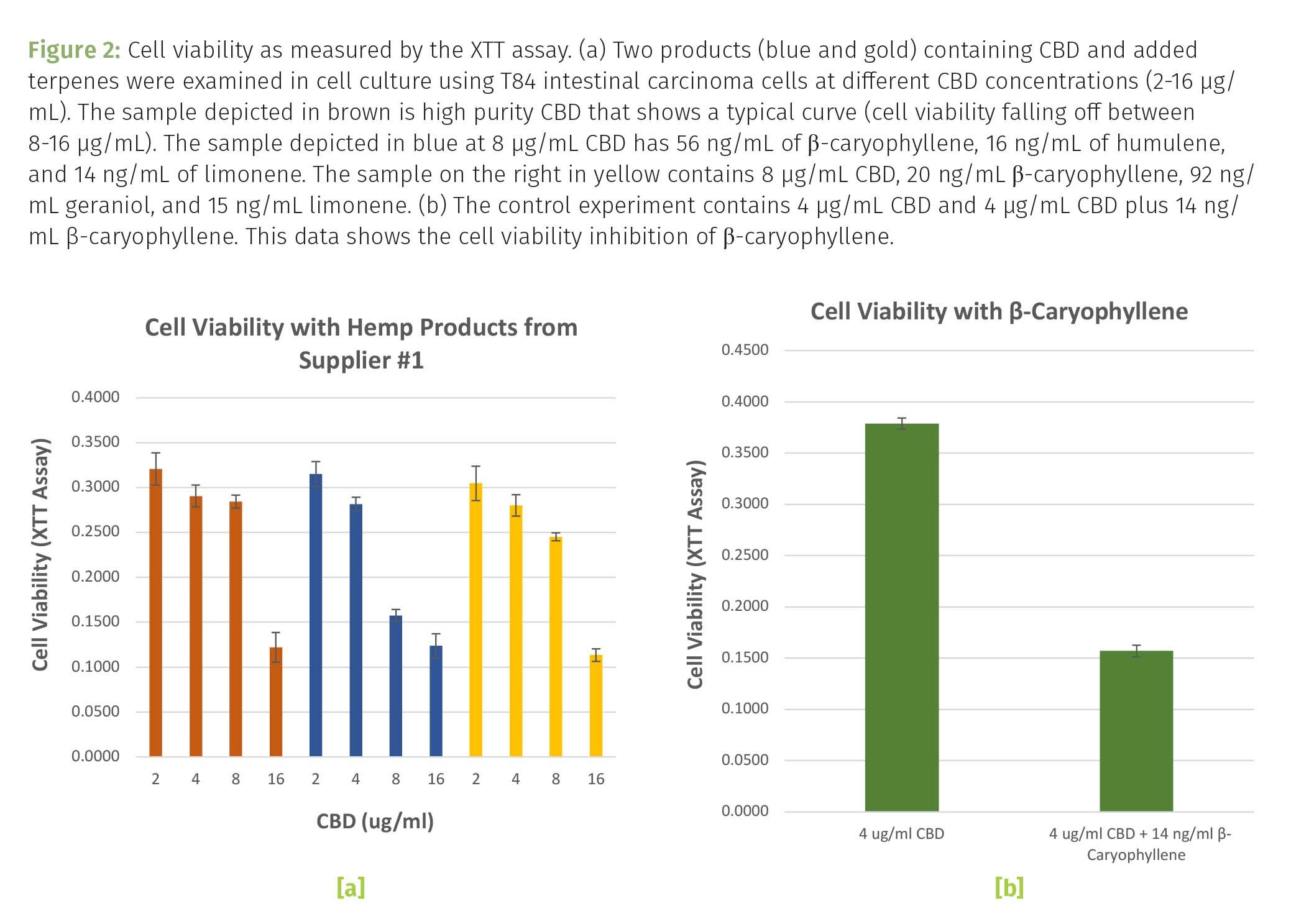
CBD also has striking effects on decreasing inflammatory cytokines when examining inflamed peripheral blood mononuclear cells (PBMCs) (Figures 3b and Table I).
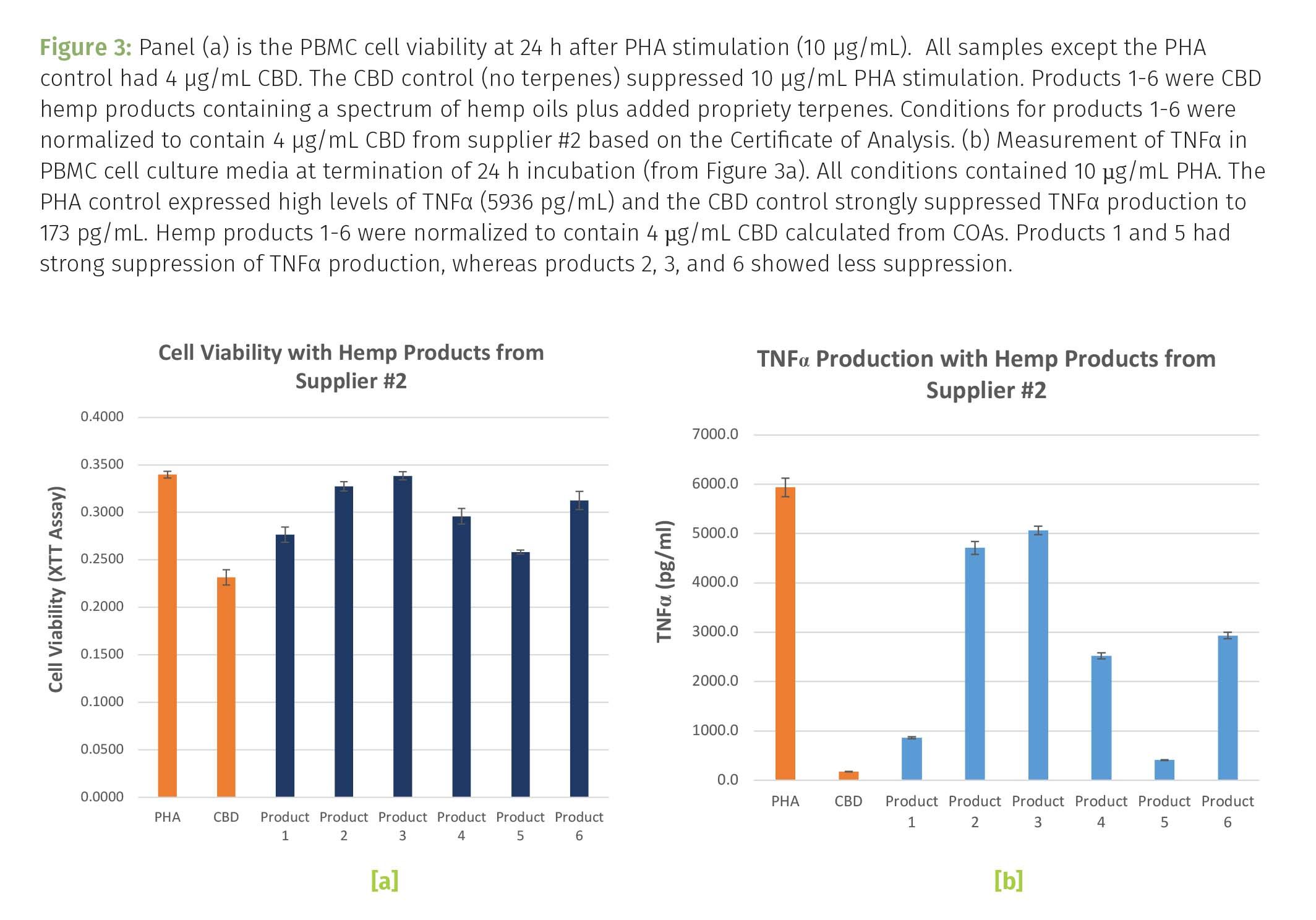
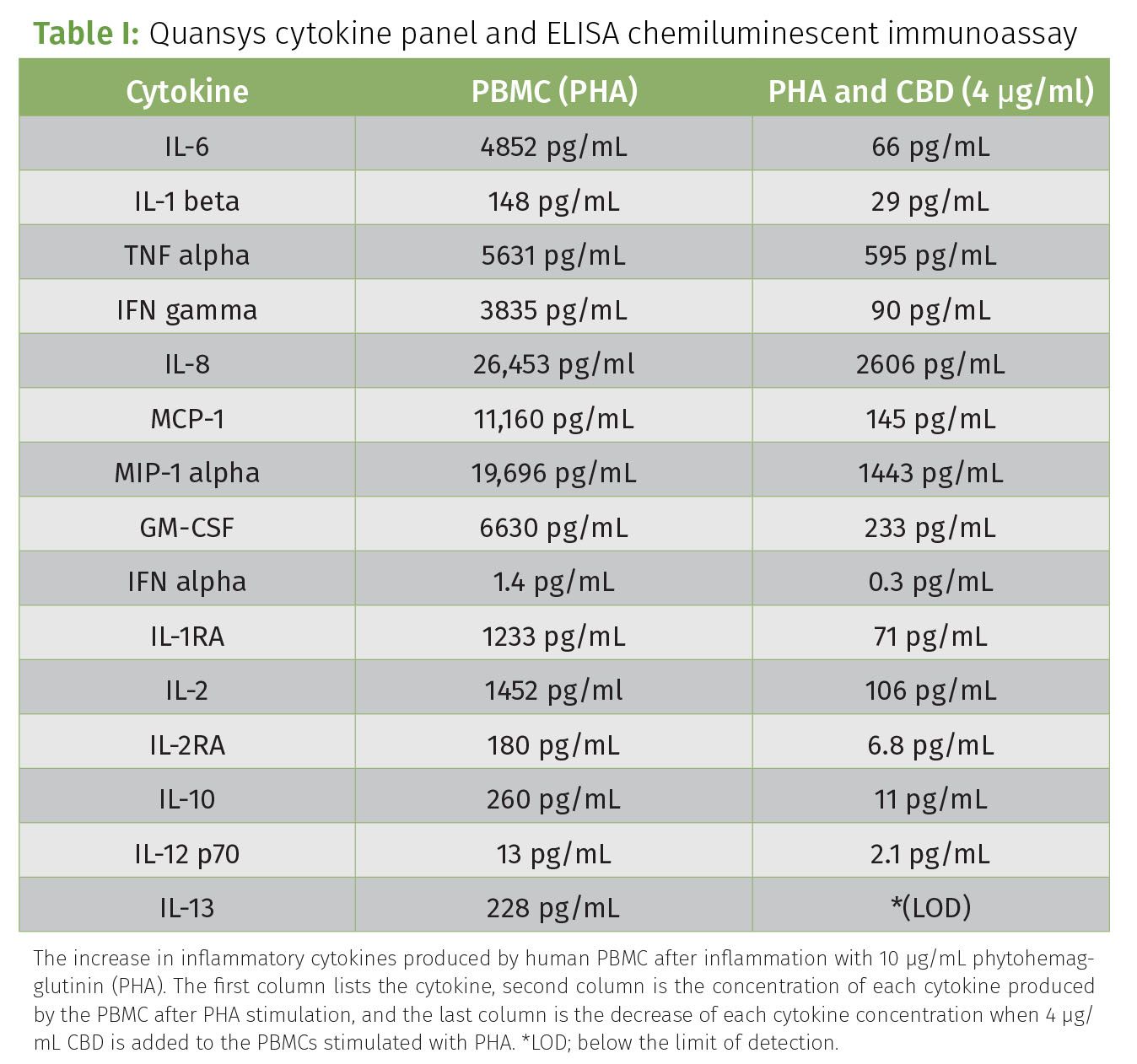
Experimental
Materials and Methods
Pure cannabidiol (99% CBD, no detectable terpenes) was obtained from Canna Hemp. Terpenes (β‐caryophyllene, humulene, limonene, and myrcene) were obtained from True Terpenes. Various culture media, chemicals, fetal bovine serum (FBS), dimethyl sulfoxide (DMSO, LC-MS grade), phytohemagglutinin (PHA), and epidermal growth factor (EGF) were purchased from Thermo Fisher Scientific. Flat bottom 96-well plates and disposable culture ware were purchased from Southern Labware. Suppliers for CBD products are unnamed as the goal of this paper is to show how to use cell culture techniques to study hemp products and not highlight or criticize specific companies. Products from supplier #1 were used for experiments depicted in Figures 2a and 2b and products from supplier #2 were used for experiments in Figures 3a and 3b.
All human cell lines were purchased from American Type Culture Collection (ATCC). The T84 cell line (colorectal carcinoma, ATCC #CCL-248) was cultured in Dulbecco’s Modified Eagles Medium (DMEM) with Glutamax/F12 in a 1:1 ratio supplemented with 5% FBS. HIEC-6 cells (normal small intestine-epithelial, ATCC #CCL-3266) were cultured in Minimum Essential Media (MEM) with Glutamax supplemented with 10 ng/mL EGF and 5% FBS. The CHP-212 cells (brain neuroblastoma, ATCC #CRL-2273) were cultured in equal parts MEM and Glutamax/F12 and supplemented with 10% FBS.
Stock cell cultures of the ATCC cell lines were grown in 25 cm2 (T25) flasks and subcultured in 200 µL of complete media into flat bottom 96-well plates. All cultures were incubated at 37 °C in a humidified atmosphere containing 5% CO2. During the incubation periods the cultures were examined daily for contamination and morphological changes with an Olympus IMT-2 inverted phase-contrast microscope at 100X and 150X magnification.
Human PBMCs from individual donors were purchased from Cellular Technology Limited (CTL). PBMC contains a mixture of cells including: T-cells, B-cells, NK cells, monocytes (blood macrophages), and dendritic cells. Culture reagents for PBMC were obtained from CTL and their protocols were strictly followed. The PBMCs were stored in the vapor phase of liquid nitrogen until the day of use. A vial of PBMCs contains about 1 x 107 cells, which were plated in quadruplicate at 2 x 105 cells/well in CTL media. PBMC cells were inflamed with 10 µg/mL PHA, which binds to toll-like-receptor 2 (TLR2) on T-cells and macrophages.
All cell culture experiments had a final concentration of 0.1% DMSO as the solvent for CBD, terpenes, or commercial hemp products. Culture supernatants (absent of cells) from completed experiments were sent overnight on dry ice to Quansys Bioscience for evaluation of cytokines and matrix metalloproteases (MMP) concentrations by an enzyme-linked immunosorbent assay (ELISA) chemiluminescent immunoassay.
Viability Assay
The XTT assay (Biotium) was used to evaluate cell viabilities at the end of culture experiments. XTT is a colorimetric detection assay utilizing tetrazolium dye to measure cell viability by enzymatic activity of the mitochondria in living cells. T84, HIEC-6, and CHP-212 cells were plated at a density of 105 cells per well in 200 µL of the appropriate media in flat bottom 96-well culture plates in quadruplicate, which reached confluency in 48 h. At the end of this incubation, the cultures were dosed with CBD (99%) as a control or CBD products containing other hemp oils and incubated for 24 h. After the appropriate incubation time, 100 µL of the culture media from each well was removed for cytokine and MMP analysis leaving 100 µL, to which 25 µL of the XTT reagent was added. The XTT plates were incubated at 37 °C for 120 min and the absorbance recorded using a Tecan Genios plate reader that detects the absorption maximum (492 nm) of XTT.
Data Analysis
All samples were done in quadruplicate and the raw data was transferred to ExcelR for statistical analysis to compare reproducibility. Processed data was graphically plotted along with standard error of means bars. CBD (99% purity) was a control utilized across all experiments.
Results and Discussion
An increase in cell viability occurs at lower dosages (2–4 µg/mL) while concentrations above 6 µg/mL CBD, the cell viability starts to decrease (Figure 1). The CBD at 10 µg/mL decreases the viability to about 50% of the control and CBD dosed at 20 µg/mL decreased cell viability to about 20%. CBD shows toxicities to cells between two or three times the effective dose of 4 µg/mL, resulting in an inverted U-shaped dose or response curve commonly observed with many drugs (11). Two other cell lines (T84 and HIEC-6) produced similar cell viability results.
Several terpenes (β‐caryophyllene, myrcene, humulene, and limonene) were examined by XTT cell viability and demonstrated growth effects in the nanogram to milliliter range. Terpenes are often volatile in 37 °C culture plates making it difficult to get precise readings, especially at higher concentrations.
It is shown in Table I that PHA-inflamed PBMCs produce high levels of many cytokines. PHA activates T-cells and macrophages through binding to TLR2. Without stimulation, PBMCs show no cell proliferation or increased cytokine production. The Quansys Cytokine Panel, which multiplexes 16 cytokines in a single well, makes these tests possible with small volumes of cell culture media.
Figures 2a and 2b illustrate the analyses of products containing CBD and terpenes in cell culture. The first sample (brown) shows a typical cell viability curve for high purity 99% CBD (no terpenes) with cell viability falling off between 8–16 µg/mL CBD (Figure 2). The second and third samples (blue and gold, respectively) contain CBD and added terpenes from supplier #1. At a concentration of 8 µg/mL CBD in the second sample (blue) there is 56 ng/mL β‐caryophyllene, 16 ng/mL humulene, and 14 ng/mL limonene. The third sample on the right (gold) at 8 µg/mL CBD contains 20 ng/mL β‐caryophyllene, 92 ng/mL geraniol, and 15 ng/mL limonene. Two control experiments contained 4 µg/mL CBD and 4 µg/mL CBD plus 14 ng/mL β‐caryophyllene (Figure 2b). The β‐caryophyllene control clearly demonstrates that 14 ng/mL β‐caryophyllene inhibits cell growth even in the presence of much larger amounts of CBD (4 µg/mL). This is of interest as β‐caryophyllene is a major terpene in many hemp cultivars. We also performed experiments demonstrating the inhibition of cell viability by combining β‐caryophyllene with humulene and limonene (data not shown). Lavigne and colleagues (3) studied cannabis terpenes and found that geraniol, linalool, and β-pinene selectively enhance cannabinoid activity.
Figure 3a illustrates the cell viability of PBMC inflamed with PHA (10 µg/mL) and incubated with six different CBD-containing hemp products from supplier #2. The two control samples contained PHA (10 µg/mL) and pure CBD (4 µg/mL) with added PHA (10 µg/mL). All six hemp products started with a high concentration of CBD hemp oil to which propriety mixtures of terpenes were added. The six samples were normalized to examine 4 µg/mL CBD in each culture. Hemp products #3 and #4 stimulate cell growth more than the 4 µg/mL of pure CBD or the other products. However, products #3 and #4, which stimulated PBMC growth, were not very effective in inhibiting TNFa production, an inflammatory cytokine.
Figure 3b shows the level of TNFa produced by the six PBMC cultures alongside two control samples (PHA and PHA plus CBD, Figure 3a). It is important to note that data in Figures 3a and 3b suggest that slight differences in added terpenes can affect cell viability and TNFa production. This is a strong indication that cellular viability experiments and cytokine determinations are useful in detecting minor differences in hemp products.
It has become standard practice to characterize cannabis oils by LC–MS and GC–MS (1,12). Several companies market sophisticated LC–MS and GC–MS instruments designed to detect different cannabinoids and many terpenes in the cannabis plants. Modern methodology can separate and detect nanogram amounts of the various oils and it is certain that newer methods are currently being developed to detect even smaller amounts. Although these are important advances, it is time to better understand the effects these oils have separately and in various combinations on human cells (13). This is especially true for the lesser cannabinoids and terpene oils. Cell culture methods should prove very useful in the near future as rare cannabinoids become commercially available: one cannot assume that all cannabinoids have the same potencies and toxicities as CBD (14).
The Israeli research group measured cell viability as a function of CBD dose using four neuroblastoma cell lines and clearly demonstrate a decrease of 50% cell viability in all four neuroblastoma cell lines below 50 µg/mL CBD (10). Two of the cell lines showed a 50% decrease in cell viability between 5–15 µg/mL CBD, which is in close agreement with our data showing a 50% decrease in cell viability at 10 µg/mL (Figure 1).
It is a common practice to use a solvent such as acetone, ethanol, methanol, DMSO, Tween 80, Tween 20, β‐cyclodextrin, dimethyl formamide, or polyethylene glycol when placing hydrophobic molecules like cannabis oils into cell culture media (15). Solvent controls should be included as it has been shown that solvents can cause proteomic and transcriptomic changes in cells that appear microscopically normal (16,17). For the above reasons, one can see the benefits of completing cell viability responses when studying single cannabinoids and products that contain a spectrum of hemp oils.
Table 1 shows that PHA stimulated the production of many cytokines in PBMC by binding to TLR2 on T-cells and macrophages. It is important to note that CBD dosed at 4 µg/mL inhibited the production of these cytokines. Similar cytokine results were observed when treating PBMC with 5 mg/mL polyinosine-polycytidylic acid (poly I:C), a synthetic double stranded RNA (dsRNA) molecule that binds to TLR3 on macrophages and dendritic cells, as do dsRNA virus (COVID-19). It has been shown that inflamed PMBCs produce a variety of cytokines important in innate immunity (18).
There are more than 100 genes encoding cytokine proteins, which are divided into several classes. There are about 33 interleukins (IL) produced mainly, but not exclusively, in immune cells (18). Complex immune reactions can be studied in PBMC; however, one should stay with one human donor for a study as there are individual differences.
The observation that CBD can lower inflammatory cytokines has previously been reported (19). Vuolo and colleagues showed that CBD lowered levels of the inflammatory cytokines IL-6 and IL-8 in an animal model of asthma. A review paper concluded that there is overwhelming evidence supporting the belief that CBD suppresses the immune system at several levels. Not only are inflammatory cytokines suppressed, but CBD directly inhibits various immune cells and induces apoptosis in certain macrophage cells (20). Although the immune suppressive properties of CBD are well documented, our data contributes to this body of research by showing that CBD suppresses a variety of cytokines in immune cells. The approach measuring cytokines in human PBMC following an overnight incubation introduces a convenient way to study the cellular effects of hemp oils.
For cells to divide, migrate, and remodel tissue they must free themselves from the extracellular matrix (basement membrane) using one or more of the 28 MMP (2). Abnormally high levels of MMP have been found in many cancers where they are associated with rapid tumor growth, invasiveness, metastases, and even decreased survival (21). Our preliminary work examining only six MMP showed that 4 µg/mL CBD inhibits MMP7 (18,670 pg/mL down to 7037 pg/mL) in T84 cells. CBD at 4 µg/mL inhibits MMP9 (8154 pg/mL down to 2056 pg/mL) in PHA-stimulated PBMC. Recently, it has been shown that CBD can inhibit MMP in skin cell cultures (9).
Conclusion
The data presented here clearly demonstrates that CBD has a characteristic cell viability response in the microgram-milliliter range (Figure 1). Data indicating the potency (ng/mL) of certain terpenes greatly complicates studying hemp products especially when suppliers are adding additional terpenes (2,4). Minute amounts of terpenes to add flavor or achieve a human effect can be accurately determined using cell viability tests.
Hemp products are not a single oil, but a complicated mixture of oils that can have unique responses in humans depending on the cultivar. The approach in this paper suggests that human cell culture methods can be used to study these complicated hemp oil mixtures under controlled conditions. More research remains to be done with different terpenes and cannabinoid combinations to better understand the complicated effects on human cells.
Acknowledgements
We thank Renee Daunay for proofreading our manuscript and Nicole Shock for technical assistance. Author contributions: Conceptualization, A.T. and V.C.; methodology, A.T. and V.C.; validation, R.L. and S.M.; formal analysis, S.M.; investigation, V.C. and A.T., resources, V.C.; data curation, V.C. and R.L.; writing—original draft preparation, A.T. and V.C.; writing—review and editing, A.T., V.C., R.L., and S.M.
References
- J.T. Fischedick, A. Hazekamp, T. Erkelens, Y.H. Choi, and R. Verpoorte, Phytochemistry71(17-18), 2058-2073 (2010).
- E.B. Russo, Br. J. Pharmacol. 163(7), 1344-1364 (2011).
- J.E. LaVigne, R. Hecksel, A. Keresztes, and J.M. Streicher, Sci. Rep. 11(1), 8232 (2021).
- S.R. Sommano, C. Chittasupho, W. Ruksiriwanich, and P. Jantrawut, Molecules25(24), 5792 (2020).
- N. Belot, B. Sim, C. Longmore, L. Roscoe, and C. Treasure, ALTEX34(4), 560-564 (2017).
- A. Edwards, L. Roscoe, C. Longmore, F. Bailey, B. Sim, and C. Treasure, ALTEX35(4), 477-488 (2018).
- I. Hubatsch, E.G. Ragnarsson, and P. Artursson, Nat. Protoc. 2(9), 2111-2119 (2007).
- H.Y. Tan, S. Trier, U.L. Rahbek, M. Dufva, J.P. Kutter, and T.L. Andresen, PLoS One. 13(5), e0197101 (2018).
- M. Zagórska-Dziok, T. Bujak, A. Ziemlewska, and Z. Nizioł-Łukaszewska, Molecules26(4), 802 (2021).
- T. Fisher, H. Golan, G. Schiby, S. PriChen, R. Smoum, I. Moshe, N. Peshes-Yaloz, A. Castiel, D. Waldman, R. Gallily, R. Mechoulam, and A. Toren, Curr. Oncol. 23(2), S15-22 (2016).
- A.W. Zuardi, N.P. Rodrigues, A.L. Silva, S.A. Bernardo, J.E.C. Hallak, F.S. Guimarães, and J.A.S. Crippa, Front. Pharmacol. 8, 259 (2017).
- B. Clifford, C. Young, A. Owens, J. Mott, and R. Lieberman, Cannabis Science and Technology. 3(1), 34-42 (2020).
- A. Shapira, P. Berman, K. Futoran, O. Guberman, and D. Meiri, Anal Chem. 91(17), 11425-11432 (2019).
- H. Koltai, P. Poulin, and D. Namdar, Eur. J. Pharm. Sci. 132, 118-120 (2019).
- K. Fidyt, A. Fiedorowicz, L. Strządała, and A. Szumny, Cancer Med. 5(10), 3007-3017 (2016).
- M. Timm, L. Saaby, L. Moesby, and E.W. Hansen, Cytotechnology65(5), 887-894 (2013).
- L. Chiricosta, S. Silvestro, J. Pizzicannella, F. Diomede, P. Bramanti, O. Trubiani, and E. Mazzon, Int. J. Mol. Sci. 20(23), 6039 (2019).
- C.A. Dinarello, Eur. J. Immunol.37(Suppl 1), S34-45 (2007).
- F. Vuolo, F. Petronilho, B. Sonai, C. Ritter, J.E. Hallak, A.W. Zuardi, J.A. Crippa, and F. Dal-Pizzol, Mediators Inflamm. 2015, 538670 (2015).
- J.M. Nichols and B.L.F. Kaplan, Cannabis Cannabinoid Res. 5, 12-31 (2020).
- K. Kessenbrock, V. Plaks, and Z. Werb, Cell141, 52-67 (2010).
About the Authors
Anthony R. Torres, Virgil D. Caldwell, Shayne Morris, and Rachael Lyon are with PhytoLife Laboratories in North Salt Lake, Utah. Direct correspondence to: Anthony R. Torres, MD, at serrotra@protonmail.com.
How to Cite this Article:
A. Torres, V. Caldwell, S. Morris, and R. Lyon, Cannabis Science and Technology 5(2), 38-45 (2022).
